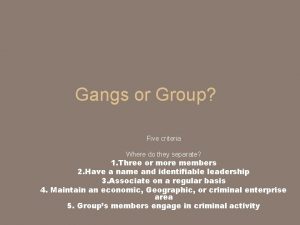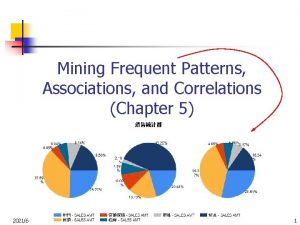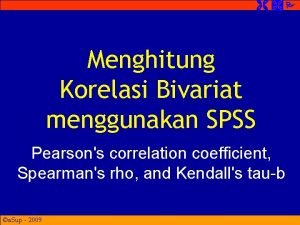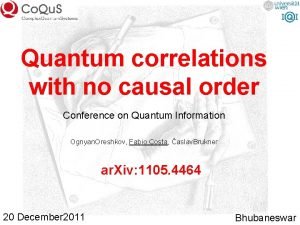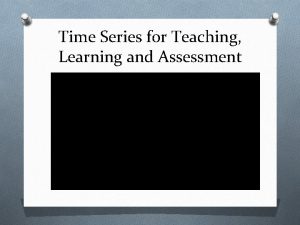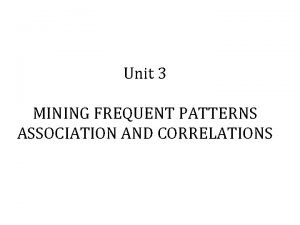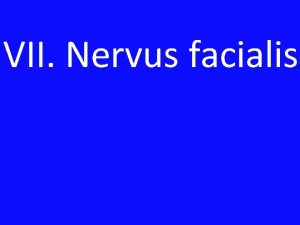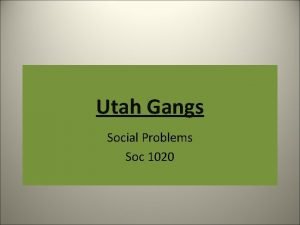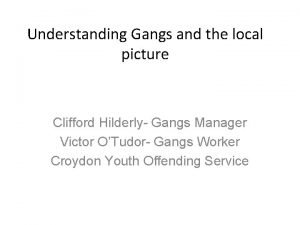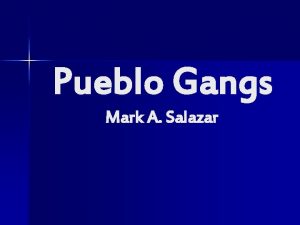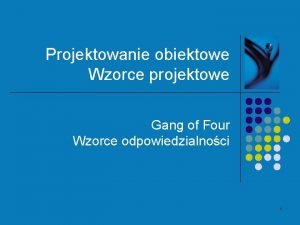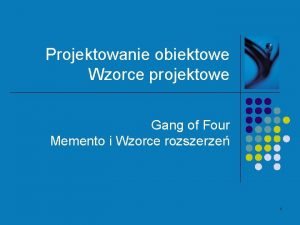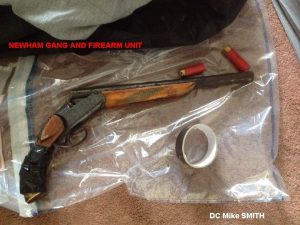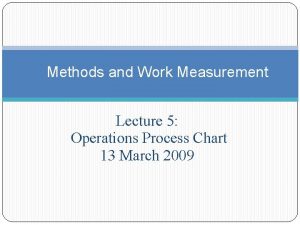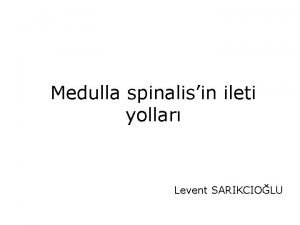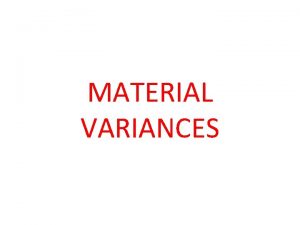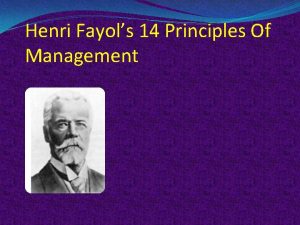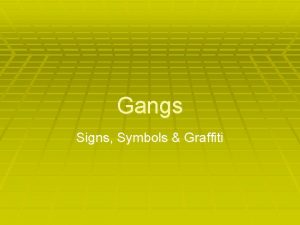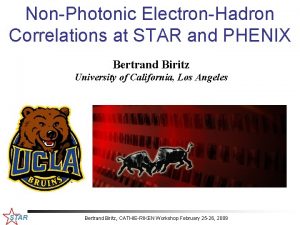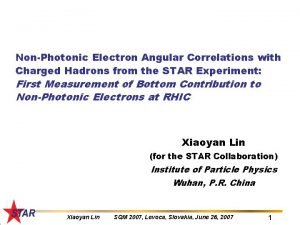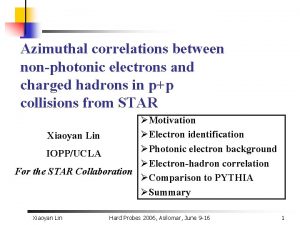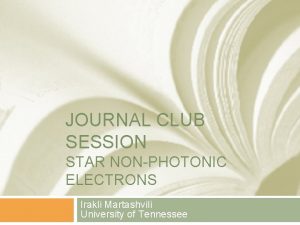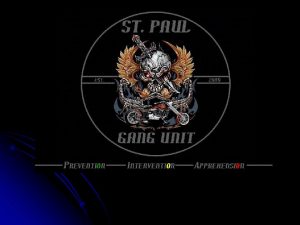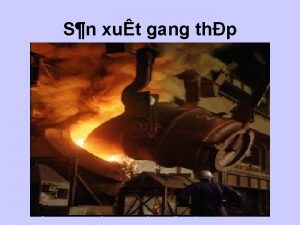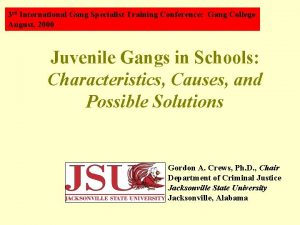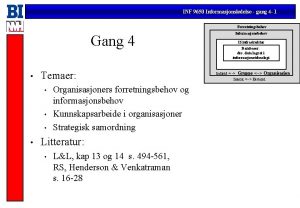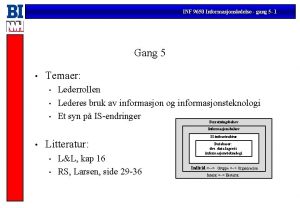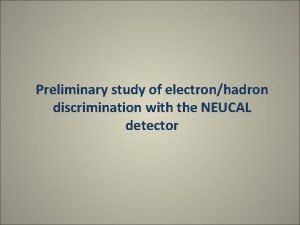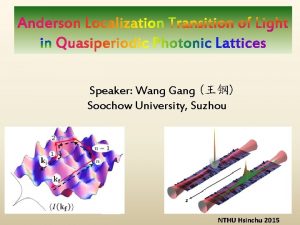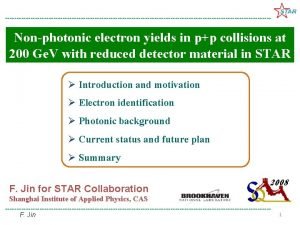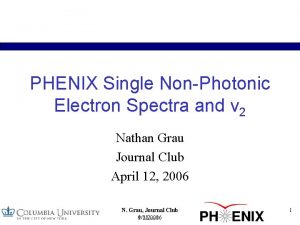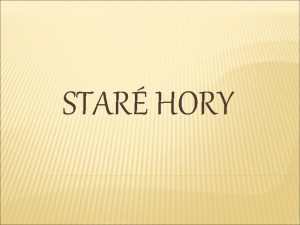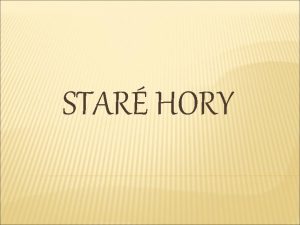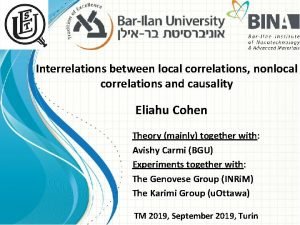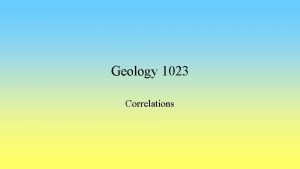NonPhotonic ElectronHadron Correlations at STAR Gang Wang University



























- Slides: 27

Non-Photonic Electron-Hadron Correlations at STAR Gang Wang (University of California, Los Angeles) for STAR Collaboration Gang Wang, Quark Matter 2008 1

Outline Ø Motivation Ø Analysis procedure Ø e-h correlations in p+p collisions Ø e-h correlations in Cu+Cu collisions Ø e-h correlations in Au+Au collisions Ø Summary Gang Wang, Quark Matter 2008 2

Near Side: Motivations trigger what’s the contribution of B/D Conical Pattern in 2 -Particle Correlations in Au+Au Collisions decay to the nonphotonic electrons? p. Ttrig = 2. 5 -4. 0 Ge. V/c; p. Tasso = 1. 0 -2. 5 Ge. V/c Mark Horner (for STAR Collaboration): J. Phys. G: Nucl. Part. Phys. 34 (2007) S 995 Away Side in medium: How does B/D lose energy? Via conical emission? Gang Wang, Quark Matter 2008 3

Non-photonic electrons PYTHIA • D mesons have their directions well represented by the daughter electrons, above 1. 5 Ge. V/c. • Electrons from B decays can represent the B meson momentum direction well if p. T > 3 Ge. V/c. Gang Wang, Quark Matter 2008 4

B vs D: contribution to non-photonic e PYTHIA X. Y. Lin, hep-ph/0602067 B D p. T_asso > 0. 3 Ge. V/c PYTHIA shows significant differences in B&D on the near-side correlations in p+p collisions, and we can fit the experimental data to obtain B/D contribution. Gang Wang, Quark Matter 2008 5

Major Detectors Used Signal: Non-photonic electron Charm decay Bottom decay Background: Hadron Photonic electron Photon conversion π0 Dalitz decay η Dalitz decay kaon decay vector meson decays Data Sample: l Time Projection Chamber (TPC) At s. NN = 200 Ge. V, p+p collisions in run 6 (2006), l Barrel Electro-Magnetic Calorimeter (BEMC) Cu+Cu collisions in run 5 (2005), l Barrel Shower Maximum Detector (BSMD) Au+Au collisions in run 7 (2007). Gang Wang, Quark Matter 2008 6

Electron ID Using TPC, BEMC and BSMD Purity: above 99% for 3 < p. T < 6 Ge. V/c in Cu. Cu and Au. Au; above 98% for 3 < p. T < 6 Ge. V/c, and 80% for 9 Ge. V/c in p+p collisions. With BEMC and BSMD, the electron peak is enhanced in the energy loss distribution, and we obtain a very pure electron sample. Gang Wang, Quark Matter 2008 7

Photonic Background e+ (global track) e- (assigned as primary track) dca e- (primary track) � • The invariant masses of the OS and SS e-pairs have different distributions. • Reconstructed photonic electron is the subtraction. • Photonic electron is the reconstructed-photonic/ ε • ε is the background reconstruction efficiency calculated from simulations. Gang Wang, Quark Matter 2008 8

Procedure to Extract the Signal of e-h Correlations All Tracks Pass EID cuts Inclusive electron Non-photonic electron Photonic electron Reco-photonic electron =Opp. Sign - combinatorics Not-reco-photonic electron =(1/eff-1)*(reco-photonic) Semi-inclusive electron Δφnon-pho = Δφsemi-incl + ΔφSame. Sign-w/-partner – (1/eff -1)*(ΔφOpp. Sign-w/o-partner – ΔφSame. Sign-w/o-partner) Each item has its own corresponding Δφ histogram. Gang Wang, Quark Matter 2008 9

Near Side in p+p Gang Wang, Quark Matter 2008 10

Non-photonic e-h correlations in p+p 200 Ge. V n Clear azim. correlation is observed around near and away side. n Fitting measured dn/dφ distribution from B and D decays, we can estimate B decay contribution to nonphotonic electron. Gang Wang, Quark Matter 2008 11

B contribution to non-photonic e in p+p 200 Ge. V See Shingo Sakai’s poster Almostbottom half-half B and D contributions to non. Substantial contributions photonic e’s at 6 < p. T < 9 Ge. V/c, and FONLL Gang Wang, Quark Matter 2008 within errors. prediction is consistent with our data 12

Away Side in Cu. Cu and Au. Au Gang Wang, Quark Matter 2008 13

e-h correlations in Cu+Cu 200 Ge. V 0 – 20%: 3 < p. Ttrig < 6 Ge. V/c & 0. 15 < p. Tasso < 0. 5 Ge. V/c ry a n i elim r RP A T S Uncertainty ZYAM about 40% non-flowfrom or fluctuation (Gang Wang, Nucl. Phys. A 774 (2006) 515. ) Non-photonic e-h azimuthal correlation is measured in one π range, On the away a broad structure or a possible double-hump Upper limits of vside, used are 60% of hadron v values measured with 2 2 and markers reflections. seebefore clear vcorrelation structures. feature hasare been observed, even subtraction. the vopen {EP} method (equivalent to v. We {2}). 2 2 Gang Wang, Quark Matter 2008 2 14

Robustness in Cu. Cu 200 Ge. V 0 – 20%: 3 < p. Ttrig < 6 Ge. V/c & 0. 15 < p. Tasso < 0. 5 Ge. V/c ry a n i elim r RP A T S The broad structure on the away side is robust when we vary the efficiency of photonic electron reconstruction (66. 5%, 60%, 70%). Gang Wang, Quark Matter 2008 15

PYTHIA simulations weighted with Cu. Cu yields 3 < p. Ttrig < 6 Ge. V/c & 0. 15 < p. Tasso < 0. 5 Ge. V/c B D Here we assume the B/D contribution in Cu. Cu is similar to that in p+p. Even if they are not similar, we don’t expect the double-hump without a medium. Gang Wang, Quark Matter 2008 16

Interpretation 3 < p. Ttrig < 6 Ge. V/c & 0. 15 < p. Tasso < 0. 5 Ge. V/c In +D only peak on the away The. PYTHIA, away side. B in e-hcontribution is similar tohas what hasone been observed in h-hside, unlike the experimental result in Mach Cu. Cone PYTHIA fit has aetc. big chi 2. correlations, and consistent with calculations Gang Wang, Quark Matter 2008 17

e-h correlations in Au+Au 200 Ge. V 0 – 20%: 3 < p. Ttrig < 6 Ge. V/c & 0. 15 < p. Tasso < 1 Ge. V/c PYTHIA R STA ina m i l e Pr ry Upper limits of v 2 used are 80% of hadron v 2 values measured with the v 2{EP} method. Gangis Wang, Quark Matter on 2008 the away side. Non-photonic e-h correlation broadened 18

Summary Ø We have measured non-photonic e-h correlations in p + p collisions to retrieve B and D contributions to non-photonic electrons up to p T ~9 Ge. V/c. We found comparable B and D c o n t r i b u t i o n s f o r e l e c t r o n p T 5. 5 ~ 9 G e V /c. Ø FONLL prediction and our e. B/(e. B+e. D) results are consistent with each other within errors. Ø The shape of non-photonic e-h azimuthal correlation function is found to be modified in central Cu+Cu and Au+Au collisions due to the presence of the dense medium created in these collisions. ØAway-side: Hint of a broad structure, similar shape to that from h-h correlations. ØInduced by heavy quark interaction with the dense medium? ØQuantitative measure and investigation of the nature of the possible conical emission pattern Gang Wang, will Quark require Matter 2008 more statistics! 19

Back up slides Gang Wang, Quark Matter 2008 20

HQ Production Mechanism n flavor creation n n 0 gluon splitting n Due to large mass, HQ productions are considered as point-like p. QCD processes HQ is produced at the initial via leading gluon fusion, and sensitive to the gluon PDF NLO p. QCD diagrams show that Q-Qbar could be not back-to-back in transverse plane We need to study this smearing effect with models Gang Wang, Quark Matter 2008 21

Electron Identification: P/E • P is measured by TPC. E is the sum of the associated BEMC point’s energy measured by BEMC. • Electrons will deposit almost all of their energy in the BEMC towers. 0. 3 < P/E <1. 5 was used to keep electrons and reject hadrons. Gang Wang, Quark Matter 2008 22

Electron Identification: Shower Size • Number of SMD hits per shower indicates shower size. • Electrons have larger number of BSMD hits than those for hadrons. • Electron candidates have to satisfy Number of BSMD hits > 1. Gang Wang, Quark Matter 2008 23

Electron Identification: Projection Distance • -3σ < Z-Dist < 3σ and -3σ < Phi-Dist < 3σ were set to remove lots of random associations between TPC tracks and BEMC points. Gang Wang, Quark Matter 2008 24

PYTHIA simulations B D Each pt bin is weighted For each pt bin, the non-photonic e-h with their correlations B_corr and D_corr are relative combined according to B’s and D’s and yields, relative contributions to the nonthen they photonic electrons: are summed Gang Wang, Quark 2008 25 (e. B*B_corr + e. DMatter *D_corr) / (e. B+e up. D)

PYTHIA simulations with Au. Au yields 3 < p. Ttrig < 6 Ge. V/c & 0. 15 < p. Tasso < 1 Ge. V/c In PYTHIA, non-photonic e-h correlation functions show different B and D contributions on the near side, and similar on the away side. Gang Wang, Quark Matter 2008 26

Middle steps in Cu. Cu 200 Ge. V 0 – 20%: 3 < p. Ttrig < 6 Ge. V/c & 0. 15 < p. Tasso < 1 Ge. V/c Semi+Comb and Photonic show different correlations. Gang Wang, Quark Matter 2008 27
 Myrrh is mine its bitter perfume
Myrrh is mine its bitter perfume Folk nation symbols
Folk nation symbols Mining frequent patterns associations and correlations
Mining frequent patterns associations and correlations Korelasi pearson spss
Korelasi pearson spss X videos
X videos Quantum correlations with no causal order
Quantum correlations with no causal order Spurious correlations
Spurious correlations Thinking critically
Thinking critically Mining frequent patterns associations and correlations
Mining frequent patterns associations and correlations Ao * algorithm
Ao * algorithm What does star (for star events) stand for?
What does star (for star events) stand for? Pawsome reading gang
Pawsome reading gang Gang rules
Gang rules N tympanicus kimin dalı
N tympanicus kimin dalı Ogden trece colors
Ogden trece colors S block gang
S block gang List of gangs in colorado
List of gangs in colorado Wzorce projektowe gang of four
Wzorce projektowe gang of four Wzorce projektowe gang of four
Wzorce projektowe gang of four Crips in oklahoma
Crips in oklahoma Blackwater london gang
Blackwater london gang Gang process chart
Gang process chart Flow process chart example
Flow process chart example şuurlu proprioseptif duyu nedir
şuurlu proprioseptif duyu nedir Material price variance
Material price variance Kilby street gang
Kilby street gang Henri fayol 14 principles of management introduction
Henri fayol 14 principles of management introduction Graffiti colors
Graffiti colors

